Thionic Fluvisols (acid sulfate soils)
Table of contents
-
Introduction
-
Parent material
-
Regional Distribution
-
Definition
-
Genesis
a. Formation of pyrite
b. Pyrite oxidation: formation of active acid sulfate
soils
c. Pyrite oxidation in the presence of carbonate
-
Spatial distribution of actual and potential acid sulfate
soils
-
Chemical characteristics of thionic Fluvisols
-
Management and Use of thionic Fluvisols
1. Introduction
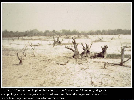 |
| Fig.1 Active acid sulfate soil landscape |
| (
Source: FAO, 2001.) |
-
Thionic Fluvisols belong to the Reference Soil Group # 4, the
Fluvisols. Further information on Fluvisols see
(
 chapter fluvisols)
. chapter fluvisols)
.
-
Other names for thionic Fluvisols are acid sulfate soils
(ASS)
a. Potential acid sulfate soils (PASS)
b. Actual or active acid sulfate soils (AASS), sometimes
named cat clays
2. Parent material and environment
-
The only difference between the parent material of thionic
Fluvisols and that of other Fluvisols is the presence of pyrite
(FeS2) in the former.
-
Thionic Fluvisols are commonly situated in coastal lowlands
and are influenced by the following conditions:
-
Sea water: contains sulfur (sulfate)
-
Sediments: contain Fe-oxides
-
Organic material: comes from mangroves
-
Anaerobic conditions and sulfate reducing
bacteria
3. Regional distribution
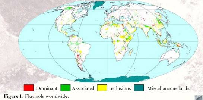 |
| Fig.2 Fluvisols worldwide |
| (
Source: FAO, 2001.) |
-
Worldwide about 24 Mio. ha (~ 0.2 %) are found, mostly in SE
Asia; often influenced by tide.
-
Thionic Fluvisols are found in the coastal lowlands
of:
a. SE Asien (Vietnam, Indonesia, Thailand)
b. W-Africa: Senegal, Gambia, Sierra Leone
c. NE-coast of S-America (Venezuela, Guyana)
4. Definition (see also Annex 3, WRB)
 http://www.fao.org/DOCREP/003/Y1899E/Y1899E00.HTM http://www.fao.org/DOCREP/003/Y1899E/Y1899E00.HTM
-
Having within 100 cm a sulfuric horizon or sulfidic soil
material.
-
Signs: occurrence of light-yellow material (jarosite).
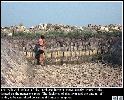 |
| Fig.3 Sulphuric horizon |
| (
Source: FAO, 2001.) |
5. Genesis
-
The majority of acid sulfate soils (ASS) were formed during
the last 10.000 years (Holocene) by sea level rising.
-
A few ASS developed in old marine stones some million years
ago.
5a. Formation of pyrite
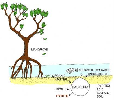 |
| Fig.4 Pyrite |
|
-
The formation of pyrite (FeS2) can
take place during sedimentation in a marine environment if the following
conditions are met:
-
Presence of Fe: most coastal sediments contain easily
reducible iron oxides or hydroxides.
-
Presence of S: seawater and brackish water contain
sulfates.
-
Anaerobic conditions : to allow reduction of sulfate and
Fe-oxides -> is met in fresh coastal sediments.
-
Fe and S-reducing microbes: occur in all coastal
sediments.
-
Organic matter: energy source for microbes and comes from
mangroves, reeds or sedges.
-
Tidal flushing: to remove the alkalinity formed in the
process of pyrite formation.
-
Slow sedimentation: to form sufficient pyrite for potentially
acid sediment.
Mechanism of pyrite
accumulation:
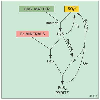 |
| Fig.5 Diagrammatic representation of the process of
pyrite formation (after Berner, 1983) |
|
-
Microorganisms reduce sulfate
(SO42-) to sulfide
(S2-) or H2S (hydrogen
sulfide) under anaerobic conditions.
-
During this process organic carbon (OC) is decomposed to form
bicarbonate (HCO3-)
ultimately (-> the electrons are needed for reduction)
-
Microorganisms reduce Fe3+ (ferric
iron) to Fe2+ (ferrous iron) and
H2S reacts with Fe (via FeS) to form pyrite
(FeS2).
 |
| Fig.6 Reaction of Pyrite |
| (
Source: FAO, 2001.) |
-
Bicarbonates
(HCO3-, alkaline) are removed
with tidal flushing, and therefore a potentially acid compound – pyrite –
remains behind.
Note:
-
When no oxidizing conditions occur: Fe and S remain in their
reduced form and the pH remains neutral -> these soils are named
potential acid sulfate soils.
-
They are brown to dark grey, soft and have a spongy
consistence.
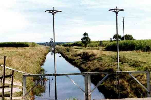 |
| Fig.7 Potential acid sulfate soils |
| (
Source: www.nor.com.au/.../ clarencecatchment/issue1.htm) |
5b. Pyrite oxidation or transformation of potential
acid sulfate soils (PASS) to actual acid sulfate soils
(AASS)
-
When pyritic sediment falls dry, O2
penetrates and pyrite is oxidized to sulfuric acid
(H2SO4) and mobile Fe (ferric
hydroxide [Fe(OH3)]) -> actual acid
sulfate soils are formed.
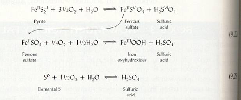 |
| Fig.8 Oxidation of pyrite to sulfuric acid |
| (
Source: Brady and Weil, 2002.) |
-
Oxidation process occurs either chemically (slow process) or
by microbial intervention through Thiobacillus ferrooxidans (accelerated
process).
-
Within days a drop in pH below pH 3 occurs.
-
Per each ton of pyrite that is oxidized, 1.64 tons of
sulfuric acid are produced.
-
Indication for the presence of potential acid sulfate
soils:
a. Aerobic incubation of the soil for some days leads to a
drastic drop in pH if the soils contain pyrite.
b. Presence of jarosite
[KFe3(SO4)2(OH)6
]6 indicates pyrite oxidation. Jarosite is an
intermediate product (partially oxidized) in the process of pyrite oxidation
and is formed under strongly oxidizing conditions at pH < 3.7. It has a
typical straw-yellow color and a malodor of cat excrements (-> cat clays).
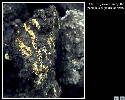 |
| Fig.9 Details of jarosite lining the pores in a
sulphuric horizon |
| (
Source: FAO, 2001.) |
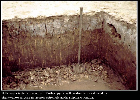 |
| Fig.10 Here: jarosite formation in in root channels
where oxygen is present |
| (
Source: FAO, 2001.) |
5c. Pyrite oxidation in the presence of
carbonate
-
In the presence of carbonates, for example shells in
mangroves,
 |
| Fig.11 Neutralising carbonate potential of oyster
shells in mangroves |
| (
Source: FAO, 2001.) |
no drop of pH occurs although sulfuric acid is
produced.
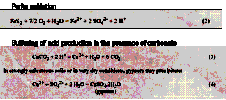 |
| Fig.12 Buffering of acid in the presence of
carbonates |
|
6. Spatial distribution of actual (AASS) and potential acid
sulfate soils (PASS)
[example: Mekong delta, Vietnam]
-
In the Mekong delta about 1 Mio ha of AASS and PASS are found
in close vicinity to each other depending on conditions during formation and
also management practices.
-
A sketch map of the Mekong delta shows that
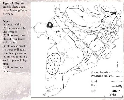 |
| Fig.13 Map of the mekong delta,
Vietnam |
| (
Source: FAO, 2001.) |
-
unit 4 contains thionic Fluvisols with pyritic sediments
(lies in a depression), whereas in
-
unit 3 and 5 Fluvisols are found. In unit 3, due to fresh
water deposits no S was present during sedimentation. In unit 5 the
sedimentation rate was too high for the formation of pyrite.
-
The high micro-variability in the spatial distribution of
AASS has a tremendous impact on agricultural management and rice
production.
-
Often AASS and PASS change within 10-20 m due to micro-relief
conditions and concomitant water level: while AASS occur on upper positions
above 85 cm PASS are found at lower terrain positions (< 75 cm above sea
level).
 |
| Fig.14 Spatial occurrence of actual and potential
acid sulfate soils of the Mekong Delta, Vietnam |
| (
Source: Dent, Pons (1995).) |
7. Chemical characteristics
-
A distinction must be made between PASS which are not yet
oxidized but contain pyrite in the soil material and AASS. Here we talk about
the unfavorable properties of AASS:
-
Low pH
-
Al-toxicity
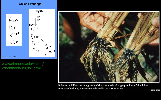 |
| Fig.15 Al-toxicity |
| (
Source: FAO, 2001.) |
-
P-deficiency: high Al causes precipitation of
Al-Phosphate complexes
-
Fe-toxicity: e.g. in flooded rice fields non-soluble
Fe3+ is oxidized to soluble
Fe2+ -> Fe toxicity may set in
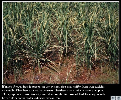 |
| Fig.16 Iron toxicity in rice
fields |
| (
Source: FAO, 2001..) |
-
H2S-toxicity: when rice soils are
flooded for long periods, sulfate is reduced to H2S
-> very toxic to plants.
-
Acidification of surface water in flooded rice: the
oxidation of Fe2+ to amorphous Fe-hydroxide
[Fe(OH)3] release of H-ions
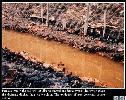 |
| Fig.17 Acidification of surface water in
flooded rice |
| (
Source: FAO, 2001.) |
-
N-deficiency: the mineralization of soil organic matter
is slow in wet, cold actual acid sulfate soils.
-
Engineering problems through acid drainage water:
sulfuric acid dissolves lime out of the concrete.
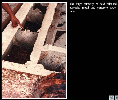 |
| Fig.18 The large quantity of acid released
corrodes metal and concrete structures |
| (
Source: FAO, 2001.) |
 |
| Fig.19 Acid drainage water |
|
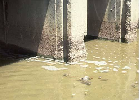 |
| Fig.20 |
|
8. Land use and management
-
A problem in the management of PASS is that FeS or
FeS2 gives the soil a black color. This often led to the
erroneous assumption that abundant SOM is present.
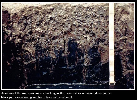 |
| Fig.21 Black pyrite - containing sulphuric layer in
the subsoil |
|
Often, drainage of the land was initiated for
agricultural land use.
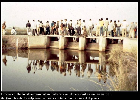 |
| Fig.22 |
| (
Source: FAO, 2001.) |
However, the drainage of soils produced aerobic
conditions: oxidation process set in and AASS were formed.
-
Similar problems occurred through reclamation and cultivation
of peat soils: drainage of water led to oxidation of pyrite and release of
sulfuric acid.
 |
| Fig.23 Development of acid sulfate soils through
reclamation of peat soils for a managment |
| (
Source: Dent, Pons (1995).) |
Reclamation and agricultural use of potential acid
sulfate soils: possibilities.
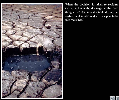 |
| Fig.24 Drainage of potential acid sulfate
soils |
| (
Source: FAO, 2001.) |
-
Drainage and complete oxidation of the soil -> flushing of
the sulfuric acid with water. Solves the problem forever. This strategy was
followed with some success in the Philippines and Sierra Leone but was
disastrous in the Netherlands and Senegal (not enough water). Disadvantages of
this method:
a. Expensive
b. Production of acid drainage water
c. Nutrient (bases) leaching
-
Gradual drainage produces less sulfuric acid. The produced
acid can be:
a. Washed out
b. Buffered by soils
c. Removed by tide (tidal flushing)
-
However, the acid production of drained floodplains can
yield 100 – 500 kg sulfuric acid per hectare and year.
-
The gradual drainage is often performed in combination
with raised beds and furrow systems.
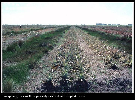 |
| Fig.25 Pineapple plants on raised beds on
potential acid sulfate soils |
| (
Source: FAO, 2001.) |
-
Important: fluctuating water levels through tide needs to
be considered.
-
A widely followed strategy: maintaining a high groundwater
table, i.e. just above the sulfuric horizon . This, however, implies investment
in water management.
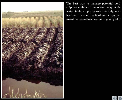 |
| Fig.26 Raised beds on potential acid sulfate
soils |
| (
Source: FAO, 2001.) |
-
Another strategy is: rice production and shrimp breeding on a
rotational basis. Rice is produced during the rainy season when soils are
flooded with fresh water. During the dry season brackish water is let in for
shrimp breeding so that sulfuric layer remains under water (anaerobic
conditions).
|

 previous |
previous |

 previous |
previous |